Controverscial.Com
![]()
Welcome
![]()
|
Controverscial.Com
Welcome
|
|
|
Controverscial.Com
Welcome
|
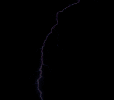
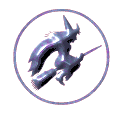

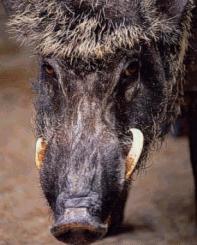
In ancient times winters were particularly harsh, cold and bleak, and for many people daily life was uncertain revolving as it did around seasonal changes intermixed with unpredictable natural phenomina such as: thunderstorms, lightening strikes, floods, drought, earthquakes, fire and vocanic irruptions. Without the evolved developments of modern day science, all such phenonima would have seemed mystical, and so much reliance was given to the veneration and apeasement of the Gods. It was a common practice therefore at major feasts such as Yule, for animals (or humans) to be ritually sacrificed and dedicated to their honour. Today, while many of the old traditions and practices are being revived, actual sacrifice is no longer politic and only symbolic alternatives are used in ritual.
One Norse tradition connected with the Goddess Freyja was the Yule Oath Boar. In Scandinavian mythology, Freyja is the Goddess of fertility, married love and the hearth. Her sacred animal was a Golden Boar called Gullinbursti (Golden Bristles), which glowed with a golden light strong enough to drive away shadows and turn night into day. At Yule, the midwinter sacrifice of a boar was therefore seen as symbolic of the death of the old sun and the rebirth of the new on the solstice.
The boar also represented fertility and the spirit of abundance and prosperity, and being sacrifice at the darkest time of the year was traditionally used for the swearing of sacred oaths to ensure to following harvest. On Yule Eve once all the family had gathered, a boar would be led around the family members for each to lay on their hands and pledge a solemn oath for the coming New Year (similar to the New Years resolutions practice of today). After the oath ceremony the boar was ritually sacrificed in the name of Freyja, and its meat used in the celebratory feast.
While today ham, pork and boar meats are still the preferred
fare at traditional Yule celebrations, loaves of bread or cakes are now baked in
the shape of a boar, which symbolically replace the once sacrificed animal.
In some traditions the bread is
made from the last sheaf of corn saved from the previous harvest.
This then takes pride of place in the centre of the tabled were it
remains throughout Yule until New Years Day.
At this time the loaf is split and the first half shared amongst the
family, while the second half is saved until the Spring then mixed with the new
corn seed to encourage a bountiful harvest.
The Wild Boar (Sus
scrofa) is a species of swine belonging to the family Suidae, of
which there are at least 16 subspecies. Historically,
the wild boar is the ancestor of the domestic pig (suborder Bunodontia)
with which today it freely interbreeds. Wild
boars originated in Western Europe and Northern Africa, but now range
across the entire continent down into the Mediterranean basin, through India and
South-East Asia to Japan, Sri Lanka, Java, Taiwan, Korea and Malaya. They have also
become established in other parts of the world, were having been introduced for
the sport of hunting, they escaped from captivity into the wild.
In the UK, Wild boars are known simply as boars, but around the world they are known by a variety of other names, including: Wild Hogs, Wild Swine, Feral Pigs, Wild Pigs, Razorbacks, Pineywoods or Rooters. Depending on location, they can also vary in size and colouration. However in general, the coat of an adult boar is coarse with bristly short hair, which is brown-to-black in colour and tending towards grey with age. They stand at about 3.5 ft (1.06 m) high at the shoulders, measure about 5 ft (1.52 m) in length nose-to-tail, and weigh in at about 200 lbs (91 kg). The head is relatively long with small erect ears tapering down into a pointed snout, and from the top of the head they have short, wiry hair forming a mane along the spine, ending at the rear in a straight long-tasselled tail.
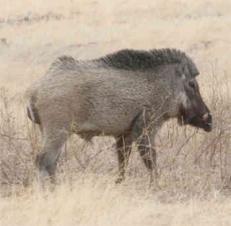
The upper and lower canine
teeth of an adult boar form into distinctive continually growing tusks, the
upper of which can measure up to 2.5 in (6.35
cm) long, but instances of much longer tusks have been found. These upper tusks curve outward and upward from the mouth and
are used for defence and digging, while the lower
smaller tusks become extremely sharp from mashing against the uppers.
In females (called sows), the canine teeth are smaller than the males,
the upper tusks being only slightly bent upwards in older individuals.
Boars are omnivorous but can adapt
easily to different habitats. They
often live in herd groups of between 20-30 individuals (called
sounders), which consist mainly
of sows and their young
offspring. Male boars reach
maturity at about 1 year old, after which they leave the herd group to roam on
their own, only returning when they have gain enough size and strength necessary
to fight and compete for females during the mating season. After
fierce fighting a dominant male has been known to mate with up to 5-6 sows in a
mating season.
Boars are mainly
nocturnal, and will travel fair distances each night when foraging for food.
Plant life and vegetation makes up for about 90% of their diet,
and consists of roots, bulbs, tubers, fruit and berries (unearthed by rooting
with their snouts and tusks). They
will also feed on mice, bird’s eggs, snakes, lizards, worms, beetles,
centipedes and carrion. Diets
change according to the seasons and variable food availability, and in times of
shortages, they are likely to become pests raiding agricultural crops such as
fields of maize, turnips and potatoes.
A sow (the female boar) will commonly produce just one annual litter of 4-6 piglets, sired by the dominant male. In temperate countries this will normally occur in the spring, while in tropical countries breeding takes place throughout a 6-9 month period, often during the moist seasons when food is plentyful. Sows have a gestation period of about 115 days, and about 3-4 days before giving birth, will leave the herd group to build a nest (called farrowing), which is basically a hollow scraped in the ground and lined and covered with a mound of twigs, vegetation and grasses. The actual birth only lasts between 2-3 hours, after which the sow and her piglets remain close to the nest for a further 4-6 days before rejoining the herd group.
When born, piglets
are generally lighter in colouration with pale yellowish
stripes but these are lost after 3-4 months as it gradually takes on a red
colouration followed by adult colouration at approximately one year of age.
Rooting behaviour develops as early as the first few days of life, and
they begin eating solid foods such as worms and grubs after about 2 weeks,
becoming fully weaned after 3-4 months. Sows
reach sexual maturity from about
8-10 months of age, but don’t generally breed until they reach 18 months old.
Wild boars have exceptional hearing and sense of smell, but poor eyesight. They are very vocal and communicate with others through a series of grunts and squeals. When frightened or alarmed for example, they blow loudly through their nose creating a snorting sound, but when hurt they squeal and when content they rumble quietly. The life expectancy of a boar in the wild is about 10 years of age, but in captivity they have been known to live as long as 25 years.
In times long gone the boar was one of the most ferocious and aggressive animals a person was likely to encounter, it was also one of the best and most popular animals to hunt being admired for both its strength and courage. Many warrior’s helmets bearing boars-head crests have been found in archaeological sites, and are thought to have been worn as a symbol of the wearers courage in battle. In Beowulf, the epic Anglo-Saxon poem (c. 700), Beowulf himself led his warriors into battle wearing a boars-head helmet as a symbol of his power and leadership.
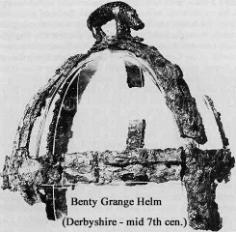
To the ancient Celts the boar was thought to have great sexual power and was regarded as a symbol of fertility, abundance and future prosperity. Charms and amulets made from a boars tusk were commonly worn for protection, and the boar was depicted on many cult objects. One can clearly be seen on the Gundestrup Cauldron (circa. 100 BCE, discovered in a Denmark peat bog in 1891), as one of the animals attending Cernunnos the Celtic Horned God.
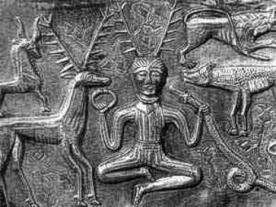
In a story from
Greek mythology (told in Homer’s epic The Iliad) the
Calydonian Boar is one of the great beasts sent by Artemis to ravage the city of
Calydon in Aetolia (a district of ancient Greece on the NW of the Gulf of
Corinth), after its King failed to
honor her in his harvest rites to the Gods.
As the story goes, King
Oeneus of Calydon regularly held his annual harvest sacrifice to the Gods on a
sacred hill near the city, but one year forgot to include the Goddess Artemis in
his offerings. Artemis (known as
the “Lady of the Bow”) was so insulted she let loose the biggest and most
ferocious boar she could find to ravage the countryside of Calydon. As it rampaged through fields and vineyards destroying their
crops, the people were forced to take refuge inside the city walls and there
began to starve.
Seeing this, King
Oeneus organised a Royal Hunt and sent out invitations to all the best hunters
in Greece offering as a prize the boar’s pelt and tusks to whoever could kill
the beast. Known as the Calydonian
Hunt, among those who responded were some members of the Argonauts who had
sailed with Jason on his search for the Golden Fleece, Meleager the King’s own
son, and a women the huntress Atalanta (known as the “indomitable”, a
daughter of Artemis). The inclusion
of a women in the hunt caused much decension amongst the other males heroes, for
many belivied women infearior and refused to hunt with her.
Meleager however was smitten by her beauty and abilities and finally
convinced them otherwise.
As the hunt progressed it was Atalanta who first came upon the mighty boar and mortally wounded it with an arrow, but it was Meleager who finally killed the beast with a thrust from his spear. Because Atalanta had drawn first blood and made it easier for him to kill it, Meleager galantly awarded her the prized pelt and tusks in tribute. However, many of the other hunters felt it a disgrace for a woman to receive the prize instead of a man, and led to the eruption of feuds and infighting amongst the heroes. The story shows however, why it was so important for the people to properly venerate the Gods, less in retribution they destroy their crops??
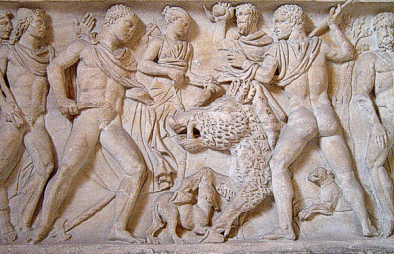
Another story from Greek
mythology concerns Adonis, the beautiful youth
beloved by the goddesses Aphrodite and Persephone. He was born of the incestuous union of King Cinyras of Cyprus
and his daughter, then concealed in a chest and placed in the custody of
Persephone, Queen of the Underworld. When
Adonis was slain by a wild boar while hunting, Aphrodite pleaded with the god
Zeus to restore him to her. Zeus
decreed that Adonis should spend the winter months with Persephone in Hades and
the summer months with Aphrodite. Again
here we can see the boar’s association with the natural cycle of life and
death in nature.
Throughout history the boar and the boar’s-head have been used in heraldry. One such is the boars-head that appears in the crest of the Clan MacKinnon in Scotland:
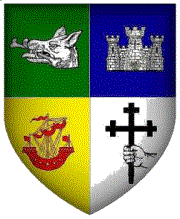
According to the Mackinnon legend explaining a boar on their crest, a member
of the clan was hunting on the shores of Loch Scavaig in Skye and after becoming
separated from his hunting party spent the night in a cave for shelter.
While preparing a leg of venison for cooking on an open fire, he was
attacked by a wild boar that had charged into the cave.
Taken by surprize the Mackinnon drove the butchered deer’s leg into the
mouth of the boar, jamming it open, before killing it.
There are of course many other representations in heraldry,
way to many for me to mention.
The Wild Boar is mostly
seen as a masculine totem for it enriches all the male virtues of bravery,
nobility and fierceness in battle, but the Sow (female) is also emboldened with
many of the same attributes, including protectiveness and fertility. While
they are generally fierce animals signifying the warrior’s spirit, they are
also clannish in nature and enjoy social interaction, but don’t let this fool
you for they are also wary of outsiders.
The Wild Boar possesses many powerful and valuable characteristics that anyone would be wise to emulate. Those who do will gain the power of enhanced courage and fearlessness when faced with adversity, as well as an increased ability to plan actions aimed at gaining success, for prosperity is also part of this totem magic. If boar shows up as your totem, he could well be asking you to stand up, have faith, and move forward without fear. If you do this, whatever fears you had will soon become distant memories rather than present reality and life can be experienced in a new and more positive manner.
The boar’s medicine is deeply
connected to the earth energies for they can often be seen rooting and foraging
in the undergrowth of plants and trees, and although they have poor eyesight,
they have excellent hearing and a sense of smell that helps them remain alert
and aware of everything around them. This
teaches us to look beneath the surface at things that may be troubling us, to
uncover what lies hidden and effectively deal with it by fine-tuning our senses
and paying attention to whatever is around us.
Boar initiates transformation through
self-discovery by using all our senses efficiently. Those with boar for a totem would be wise to follow his lead,
for by doing so, you can strengthen and develop your character and improve the
quality of your life. Boar is a
powerful totem to have, but not an easy one to work with, for order and
efficiency in all we do is a main part of his medicine.
Microsoft ® Encarta ® 2006. © 1993-2005 Microsoft Corporation. All rights reserved.
Penguin Hutchinson Reference Library (c) 1996 Helicon Publishing and Penguin Books Ltd
The Golden Bough: A Study in Magic and Religion - by James George Frazer.
Animal-Wise: The Spirit Language and Signs of Nature - by Ted Andrews
Plus to many websites to mention.
Written and compiled on
the 20th November 2009 © George Knowles
![]()
![]()

Let there be peace in the world - Where have all the flowers gone?
My Personal Page / My Place in England, UK / My Family Tree (Ancestry)
Wicca/Witchcraft / What is Wicca / What is Magick
Traditional Writings:
Wiccan Rede / Charge of the Goddess / Charge of the God / The Three-Fold Law (includes The Law of Power and The Four Powers of the Magus) / The Witches Chant / The Witches Creed / Descent of the Goddess / Drawing Down the Moon / The Great Rite Invocation / Invocation of the Horned God / The 13 Principles of Wiccan Belief / The Witches Rede of Chivalry / A Pledge to Pagan Spirituality
Correspondence Tables:
Incense / Candles / Colours / Magickal Days / Stones and Gems / Elements and Elementals
Traditions Part 1 - Alexandrian Wicca / Aquarian Tabernacle Church (ATC) / Ár Ndraíocht Féin (ADF) / Blue Star Wicca / British Traditional (Druidic Witchcraft) / Celtic Wicca / Ceremonial Magic / Chaos Magic / Church and School of Wicca / Circle Sanctuary / Covenant of the Goddess (COG) / Covenant of Unitarian Universalist Pagans (CUUPS) / Cyber Wicca / Dianic Wicca / Eclectic Wicca / Feri Wicca /
Traditions Part 2 - Gardnerian Wicca / Georgian Tradition / Henge of Keltria / Hereditary Witchcraft / Hermetic Order of the Golden Dawn (H.O.G.D.) / Kitchen Witch (Hedge Witch) / Minoan Brotherhood and Minoan Sisterhood Tradition / Nordic Paganism / Pagan Federation / Pectic-Wita / Seax-Wica / Shamanism / Solitary / Strega / Sylvan Tradition / Vodoun or Voodoo / Witches League of Public Awareness (WLPA) /
Gods and Goddesses (Greek
Mythology) / Esbats &
Full Moons / Links
to Personal Friends & Resources / Wicca/Witchcraft
Resources / What's a spell? /
Circle Casting and
Sacred Space / Pentagram
- Pentacle / Marks
of a Witch / The Witches
Power / The Witches Hat
/ An
esoteric guide to visiting London / Satanism
/ Pow-wow
/ The
Unitarian Universalist Association / Numerology: Part 1
/ Part 2 / Part
3 / A
history of the Malleus Maleficarum: includes: Pope
Innocent VIII /
The
papal Bull /
The
Malleus Maleficarum /
An extract from the Malleus Maleficarum
/ The letter of approbation
/ Johann
Nider’s Formicarius /
Jacob
Sprenger /
Heinrich Kramer /
Stefano Infessura
/ Montague Summers /
The Waldenses
/ The Albigenses
/
The Hussites / The
Sun Dance
/ Shielding (Occult
and Psychic Protection) /
Sabbats in History and Mythology / Samhain (October 31st) / Yule (December 21st) / Imbolc (February 2nd) / Ostara (March 21st) / Beltane (April 30th) / Litha (June 21st) / Lughnasadh (August 1st) / Mabon (September 21st)
Rituals contributed by Crone: Samhain / Yule / Imbolc / Ostara / Beltane / Litha / Lammas / Mabon
Tools of a Witch / The Besom (Broom) / Poppets and Dolls / Pendulums / Cauldron Magick / Mirror Gazing
Animals in Witchcraft (The Witches Familiar) / Antelope / Bats / Crow / Fox / Frog and Toads / Goat / Honeybee / Kangaroo / Lion / Owl / Phoenix / Rabbits and Hares / Raven / Robin Redbreast / Sheep / Spider / Squirrel / Swans / Wild Boar / Wolf / Serpent / Pig / Stag / Horse / Mouse / Cat
In Worship of Trees - Myths, Lore and the Celtic Tree Calendar. For descriptions and correspondences of the thirteen sacred trees of Wicca/Witchcraft see the following: Birch / Rowan / Ash / Alder / Willow / Hawthorn / Oak / Holly / Hazel / Vine / Ivy / Reed / Elder. Also see: The Willow Tree (Folk Music)
Mystical Sacred Sites - Stonehenge / Glastonbury Tor / Malta - The Hypogeum of Hal Saflieni / Avebury / Cerne Abbas - The Chalk Giant / Ireland - Newgrange /
Rocks and Stones:
Stones - History, Myths and Lore
Articles contributed by Patricia Jean Martin: / Apophyllite / Amber / Amethyst / Aquamarine / Aragonite / Aventurine / Black Tourmaline / Bloodstone / Calcite / Carnelian / Celestite / Citrine / Chrysanthemum Stone / Diamond / Emerald / Fluorite / Garnet / Hematite / Herkimer Diamond / Labradorite / Lapis Lazuli / Malachite / Moonstone / Obsidian / Opal / Pyrite / Quartz (Rock Crystal) / Rose Quartz / Ruby / Selenite / Seraphinite / Silver and Gold / Smoky Quartz / Sodalite / Sunstone / Thunderegg / Tree Agate / Zebra Marble
Wisdom:
Knowledge vs Wisdom by Ardriana Cahill / I Talk to the Trees / Awakening / The Witch in You / A Tale of the Woods
Articles and Stories about Witchcraft:
Murder by Witchcraft / The Fairy Witch of Clonmel / A Battleship, U-boat, and a Witch / The Troll-Tear (A story for Children) / Goody Hawkins - The Wise Goodwife / The Story of Jack-O-Lantern / The Murder of the Hammersmith Ghost / Josephine Gray (The Infamous Black Widow) / The Two Brothers - Light and Dark
Old Masters of Academia:
Pliny the Elder / Hesiod / Pythagoras
Abramelin the Mage / Agrippa / Aidan A. Kelly / Albertus Magnus “Albert the Great” / Aleister Crowley “The Great Beast” / Alex Sanders "the King of the Witches” / Alison Harlow / Amber K / Anna Franklin / Anodea Judith / Anton Szandor LaVey / Arnold Crowther / Arthur Edward Waite / Austin Osman Spare / Biddy Early / Bridget Cleary / Carl Llewellyn Weschcke / Cecil Hugh Williamson / Charles Godfrey Leland / Charles Walton / Christina Oakley Harrington / Damh the Bard (Dave Smith) / Dion Fortune / Dolores Aschroft-Nowicki / Dorothy Morrison / Doreen Valiente / Edward Fitch / Eleanor Ray Bone “Matriarch of British Witchcraft” / Dr. John Dee and Edward Kelly / Dr. Leo Louis Martello / Eliphas Levi / Ernest Thompson Seton / Ernest Westlake and the Order of Woodcraft Chivalry / Fiona Horne / Friedrich von Spee / Francis Barrett / Gerald B. Gardner / Gavin and Yvonne Frost and the School and Church of Wicca / Gwydion Pendderwen / Hans Holzer / Helen Duncan / Herman Slater "Horrible Herman" / Israel Regardie / James "Cunning" Murrell / Janet Farrar & Gavin Bone / Jessie Wicker Bell “Lady Sheba” / John Belham-Payne / John George Hohman / John Gerard / John Gordon Hargrave (the White Fox) / John Michael Greer / John Score / Johannes Junius the Burgomaster of Bamberg / Joseph John Campbell / Karl von Eckartshausen / Laurie Cabot "the Official Witch of Salem" / Lewis Spence / Margaret Alice Murray / Margot Adler / Marie Laveau the " Voodoo Queen of New Orleans" / Marion Weinstein / Matthew Hopkins “The Witch-Finder General” / Max Ehrmann and the Desiderata / Monique Wilson the “Queen of the Witches” / Montague Summers / Nicholas Culpeper / Nicholas Remy / M. R. Sellers / Mrs. Grieve "A Modern Herbal" / Oberon and Morning Glory Zell-Ravenheart / Old Dorothy Clutterbuck / Old George Pickingill / Paddy Slade / Pamela Colman-Smith / Paracelsus / Patricia Crowther / Patricia Monaghan / Patricia “Trish” Telesco / Philip Emmons Isaac Bonewits / Philip Heselton / Raymond Buckland / Reginald Scot / Robert Cochrane / Robert ‘von Ranke’ Graves and "The White Goddess" /
Rudolf Steiner / Rosaleen Norton “The Witch of Kings Cross” / Ross Nichols and The Order of Bards, Ovates & Druids / Sabrina - The Ink Witch / Scott Cunningham / Selena Fox / Silver Ravenwolf / Sir Francis Dashwood / Sir James George Frazer / S.L. MacGregor Mathers and the “Hermetic Order of the Golden Dawn” / Starhawk / Stewart Farrar / Sybil Leek / Ted Andrews / The Mather Family - includes: Richard Mather, Increase Mather, Cotton Mather / Thomas Ady / Vera Chapman / Victor Henry Anderson / Vivianne Crowley / Walter Brown Gibson / William Butler Yeats / Zsuzsanna Budapest
Many of the above biographies are brief and far from complete. If you know about any of these individuals and can help with aditional information, please cantact me privately at my email address below. Many thanks for reading :-)
While I have taken due care and dilligence to credit all sources where possible, this website may contain copyrighted material which has not been specifically authorized by the copyright owner. My use of making such material available here is done so in my efforts to advance our understanding of religious discrimination, the environmental and social justice issues etc. If you wish to use copyrighted material from this wedsite for purposes of your own then you must obtain permission from the relevant copyright owner yourself.
![]()
My online email discussion group:
http://groups.yahoo.com/group/Email_Witches

Help send a message of peace around the world! The Dove of Peace flies from site to site, through as many countries as possible. It does not belong to ANY belief system. Please help make a line around the globe by taking it with you to your site, by giving it to someone for their site, by passing it on to another continent or to the conflict areas of the world. May trouble and strife be vanquished in it's path.

mailto:George@controverscial.com
![]()
|
|